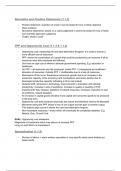Normative and Positive Statements (1.1.2)
- Positive statement: assertion of a fact/ it can be tested for true or false/ objective
- Uses evidence
- Normative statements: based on a value judgement/ it cannot be tested for true or false/
non-scientific approach/ subjective
- ‘Ought, should, could’
PPF and Opportunity Cost (1.1.3 & 1.1.4)
- Opportunity cost: measuring the next best alternative foregone. It is used to ensure a
more efficient use of resources.
- PPF: shows the combination of 2 goods that could be produced by an economy if all its
resources were fully employed and efficient.
- Govt has an oppt cost of where to allocate government spending. E.g. education or
healthcare
- On PPF = all resources are fully employed. Inside PPF = Unemployed and inefficient
allocation of resources. Outside PPF = Unattainable due to a lack of resources.
- Movements of the curve: Expansions (economic growth due to an increase in the
productive capacity of the economy) and Contractions (economic decline due to
decreased productive capacity indicating a full in real output).
- Outward shift: advances in technology, improvements in education and training/
productivity, increase in size of workforce. Increase in quality or quantity of FoP.
- Inwards shift: War, disease, depletion of natural resources, recession, reduction in size
of workforce, natural disasters
- An increase in capital goods will allow more capital and consumer goods to be produced
in the long term.
- Opportunity cost arise because resources are scarce and therefore need to be allocated
- Movement along the PPF shows a loss of one output and the gain of another output.
This depicts oppt cost as it shows the next best alternative forgone.
- Non-renewable resources = those which will eventually be completely depleted. E.g.
Natural, Gas, Oil and Coal.
EVAL: Opportunity cost elsewhere
Magnitude of investment which may reduce or increase PPF
Long run and Short run implications
Specialisation (1.1.5)
- Division of labour = when workers specialise in very specific tasks (work divided up)
Adam Smith.
, - Specialisation = Process wherein a company or industry decides to focus their labour on
a specific type of production.
- Benefits of division of labour - less training needed, less time wastage, increased
productivity (higher earnings for workers), increased output and efficiency which reduces
costs (higher profits).
- Negatives of division of labour - Monotony of workers (increase staff turnover +
recruitment costs), boredom, repetitive work, loss of skills therefore lack in flexibility for
workers, over-dependence on workers.
- Positives of specialisation = economies of scale, division of labour, lower costs and
increased efficiency leading to lower prices, training costs reduced, more internationally
competitive, higher income raising standards of living
- Negatives of specialisation = Monotony, lack of productivity, some industries can’t
compete with low prices creating a monopoly style industry, structural unemployment
during a recession, over-dependency (primary product), resource depletion.
- Staff turnover - total number of employees who leave over a certain period of time.
- Functions of money:
1. Medium of exchange: money facilitates exchange of goods and services without
the need for barter
2. Measure of value: Ascribing a value to good and service allows buyer and seller
to exchange agreeable.
3. Store of value: Money holds its value over time. Therefore it can be saved.
4. A method of deferred payment: Money is an acceptable way to arrange terms of
credit and settle future debts. Allows consumers and producers to acquire goods
in the present and pay for them in the future.
Types of Economies (1.1.6)
- Free market = Private ownership and price mechanism allocated resources with no govt
intervention (invisible hand/market forces of demand and supply). Laissez faire
economy. Fredrich Hayek and Adam Smith.
- Command economy = State ownership of resources, greater equality of income and
wealth. Providing a welfare system. Karl Marx.
- Mixed economy = Combination of free market and command economy. Some resources
are allocated by price mechanism and some by state.
- Free market advantages: Profit incentive to motivate people to work. Reduces risk of
govt failure, encourages innovation and product development. Consumer sovereignty
- Free market disadvantages: Inequality increases, wealth concentrated, workers
exploited, environmental degradation.
- Command advantage: Social equality, no exploitation, less unemployment, merit goods
encouraged.
- Command disadvantage: disincentive to work, less innovation and product development,
create black market.





